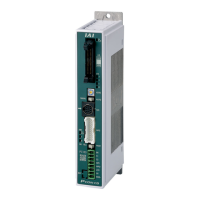6. Parameter
6.2 Servo Adjustment
6-59
ME0342-4B
No. Problems Adjustment method
In particular, high-pitched
noise occurs when stopping
or at low speed (50mm/s or
less).
• Enter Parameter No. 33 "Torque Filter Constant". As a
setting guideline, try to increase by 50 respectively. If it
is too large, stability of the control system may be
impaired and vibration may occur.
[Important] Before adjustment
This phenomenon is likely to occur when the rigidity of
the mechanical system is not maintained. Even with the
actuator alone, resonance may occur in the belt drive or
if the stroke exceeds 600mm.
Before adjustment, make sure that:
1) Parameter No. 7 "Servo Gain Number", Parameter No.
31 "Velocity Loop Proportional Gain" and Parameter No.
32 "Velocity Loop Integral Gain" are not set too high.
2) Rigidity of the load is maintained as much as possible.
Mounting is not loose and there is no play, etc.
3) The actuator body has been installed firmly with the
prescribed torque.
4) There is no distortion on the mounting surface of the
5 • Trajectory accuracy
needs to be higher
• Constant speed needs to
be higher
• Response needs to be
better
• Refer to adjustment methods No. 1 to 3 described above
and adjust Parameter No. 7 "Servo Gain Number" and
Parameter No. 31 "Velocity Loop Proportional Gain" to
optimize the conditions.
[Reference]
Selection of the actuator (motor) is the most important
factor.
The servo motor is very sensitive to the magnitude of
load inertia. If the moment of inertia on the load side
(load inertia) is too large with respect to the moment of
inertia of the motor itself (motor inertia), the servo motor
will cause the motor to be wagged by the load, as it
were, resulting in unstable control.
Therefore, in order to improve trajectory, position, speed,
response, etc., it is necessary to reduce the load inertia
ratio.
For applications such as coating, if trajectory accuracy,
constant velocity, response, etc. are called for, it is
recommended to make the actuator ball screw lead as
small as possible and to select an actuator with a higher
6.2 Servo Adjustment
ME0342-4B 6-60
No. Problems Adjustment method
• The static friction of the
load is large and travel
start is slow
• The load inertia is large
and response is poor
when stopping
• Operation time needs to
• Set Parameter No. 71 "Positional Feedforward Gain".
Estimated setting is from 10 to 50. As the set value
increases, the deviation amount is reduced and
responsiveness improves.
Setting a high value may cause vibration or noise.
• Adjust Parameter No. 7 "Servo Gain Number" and
Parameter No. 31 "Velocity Loop Proportional Gain" to
further improve responsiveness.
7 There is a shock when
starting or stopping
• Set Parameter No. 55 "Position Command Primary Filter
Time Constant" to about 50 ms.
If no improvement is observed, increase gradually. If
improvement is observed, gradually lower the set value
to the limit. If this setting is made, the settling time will be
extended and the tact time will increase. Positioning
accuracy also deteriorates.

